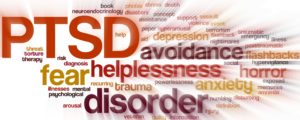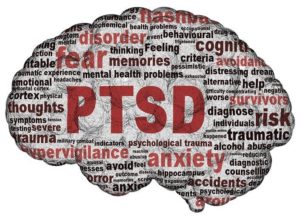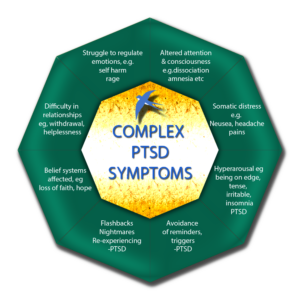Can children have PTSD?
Children can have PTSD too. They may have symptoms described above or other symptoms depending on how old they are. As children get older, their symptoms are more like those of adults. Here are some examples of PTSD symptoms in children:
- Children under 6 may get upset if their parents are not close by, have trouble sleeping, or act out the trauma through play.
- Children age 7 to 11 may also act out the trauma through play, drawings, or stories. Some have nightmares or become more irritable or aggressive. They may also want to avoid school or have trouble with schoolwork or friends.
- Children age 12 to 18 have symptoms more similar to adults: depression, anxiety, withdrawal, or reckless behavior like substance abuse or running away.
People with PTSD may also have other problems. These may include:
- Feelings of hopelessness, shame, or despair
- Depression or anxiety
- Drinking or drug problems
- Physical symptoms or chronic pain
- Employment problems
- Relationship problems, including divorce
What helps? Research shows that high levels of social support after the war or event the person has gone through were important for those women and men Veterans including those not veterans.
“Getting better” means different things for different people. There are many different treatment options for PTSD. For many people, these treatments can get rid of symptoms altogether. Others find they have fewer symptoms or feel that their symptoms are less intense. Your symptoms don’t have to interfere with your everyday activities, work, and relationships.
What can you do to find help?
If you are having a hard time dealing with your wartime memories, there are a number of things that you can do to help yourself. There are also ways you can seek help from others.
- Do things to feel strong and safe in other parts of your life, like exercising, eating well, and volunteering.
- Talk to a friend who has been through the war or other hard times. A good friend who understands and cares is often the best medicine.
- Join a support group. It can help to be a part of a group. Some groups focus on war memories. Others focus on the here and now. Still others focus on learning ways to relax.
- Talk to a professional. It may be helpful to talk to someone who is trained and experienced in dealing with aging and PTSD. There are proven, effective treatments for PTSD. Your doctor can refer you to a therapist. You can also find information on PTSD treatment within VA at: VA PTSD Treatment Programs.
- Tell your family and friends about LOSS and PTSD. It can be very helpful to talk to others as you try to place your long-ago wartime experiences into perspective. It may also be helpful for others to know what may be the source of your anger, nerves, sleep, or memory problems. Then they can provide more support.
Don’t be afraid to ask for help. Most of all, try not to feel bad or embarrassed to ask for help. Asking for help when you need it is a sign of wisdom and strength.
Don’t let PTSD get in the way of your life, hurt your relationships, or cause problems at work or school.
PTSD treatment can help.
Learn what treatment is like to help you make choices about what’s best for you.
If you suspect that you or a loved one has post-traumatic stress disorder (PTSD), it’s important to seek help right away. The sooner PTSD is confronted, the easier it is to overcome. If you’re reluctant to seek help, keep in mind that PTSD is not a sign of weakness, and the only way to overcome it is to confront what happened to you and learn to accept it as a part of your past.
TYPES OF TREATMENT:
- Trauma-focused cognitive-behavioral therapy. Cognitive-behavioral therapy for PTSD and trauma involves carefully and gradually “exposing” yourself to thoughts, feelings, and situations that remind you of the trauma. Therapy also involves identifying upsetting thoughts about the traumatic event–particularly thoughts that are distorted and irrational—and replacing them with more balanced picture.
- Family therapy. Since PTSD affects both you and those close to you, family therapy can be especially productive. Family therapy can help your loved ones understand what you’re going through. It can also help everyone in the family communicate better and work through relationship problems caused by PTSD symptoms.
- Medication is sometimes prescribed to people with PTSD to relieve secondary symptoms of depression or anxiety. Antidepressants such as Prozac and Zoloft are the medications most commonly used for PTSD. While antidepressants may help you feel less sad, worried, or on edge, they do not treat the causes of PTSD.
- EMDR (Eye Movement Desensitization and Reprocessing) incorporates elements of cognitive-behavioral therapy with eye movements or other forms of rhythmic, left-right stimulation, such as hand taps or sounds. Eye movements and other bilateral forms of stimulation are thought to work by “unfreezing” the brain’s information processing system, which is interrupted in times of extreme stress.
When looking for a therapist for post-traumatic stress disorder (PTSD), seek out mental health professionals who specialize in the treatment of trauma and PTSD. You can start by asking your doctor if he or she can provide a referral to therapists with experience treating trauma. You may also want to ask other trauma survivors for recommendations, or call a local mental health clinic, psychiatric hospital, or counseling center.


